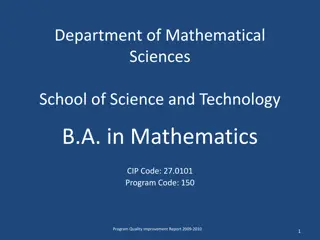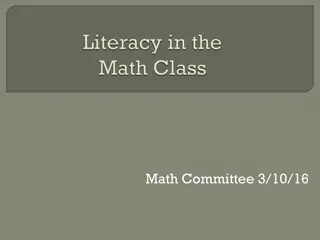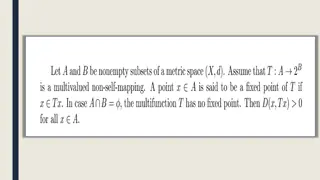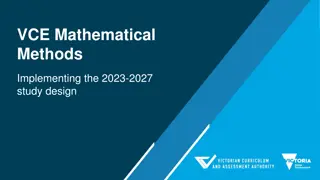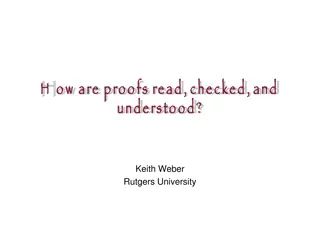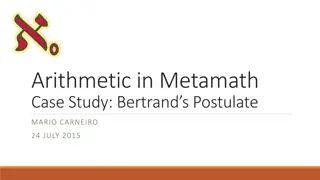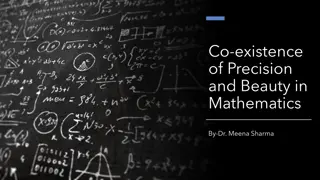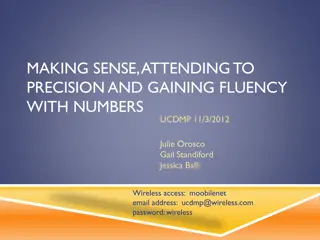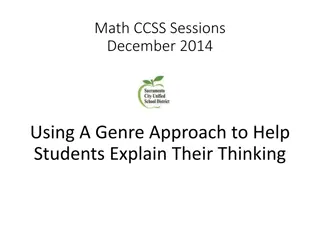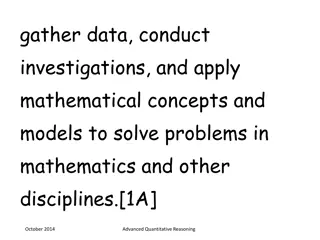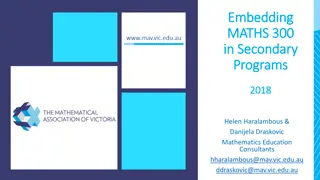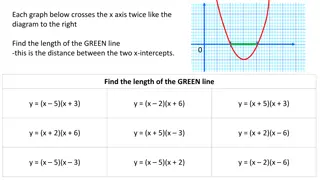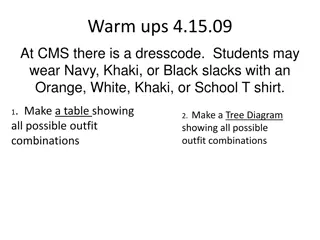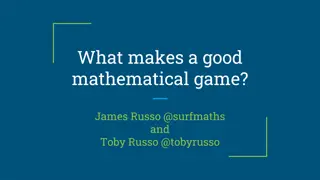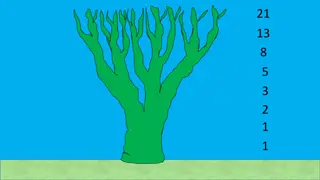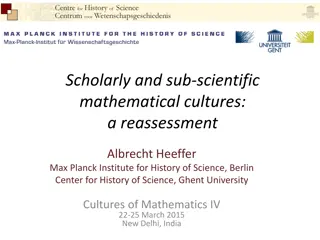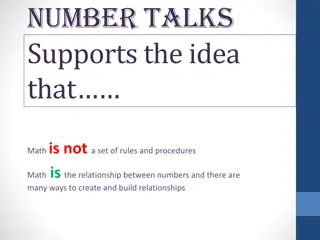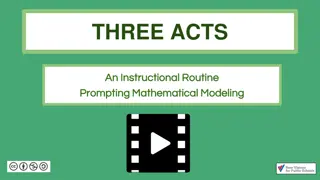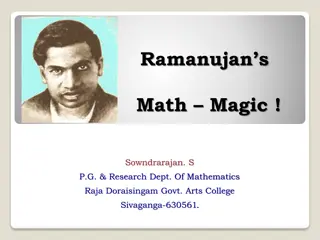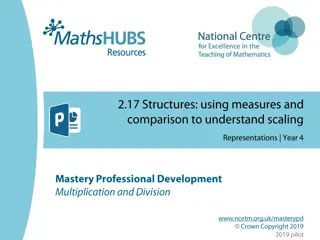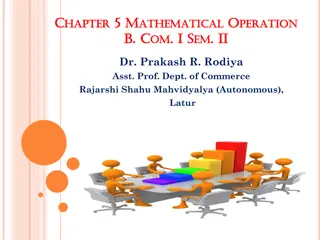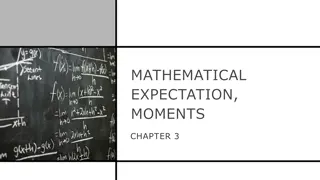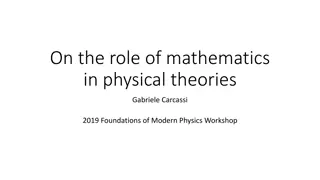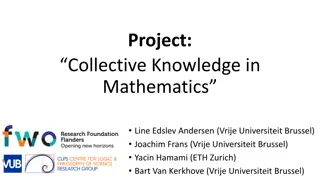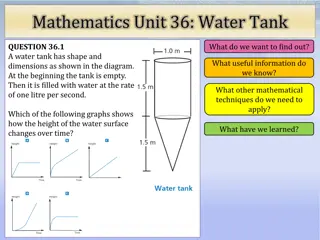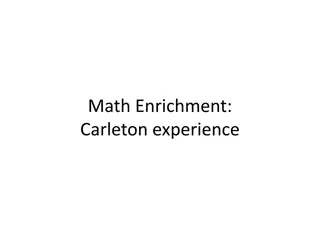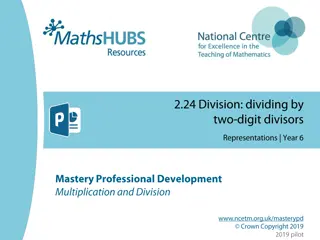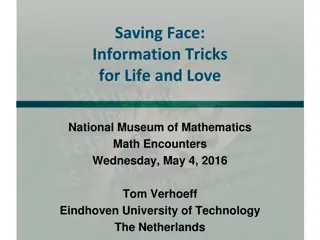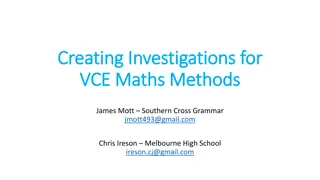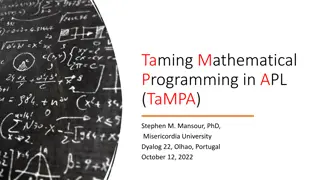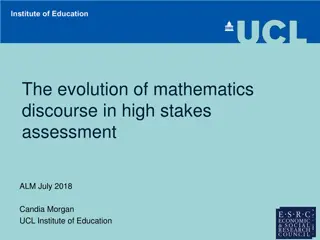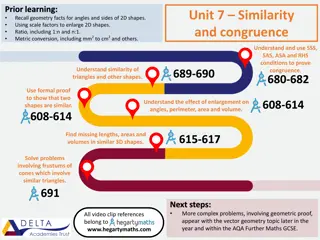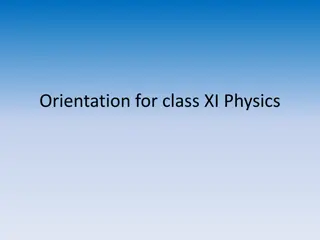Comprehensive Overview of Mathematical Methods and Resources
Covering topics such as interpolation, curve fitting, algebraic equations, transcendental equations, numerical differentiation, integration, Fourier series, Fourier transforms, partial differential equations, vector calculus, and finite difference methods. Includes recommended textbooks and references for further study in mathematical methods.
Download Presentation

Please find below an Image/Link to download the presentation.
The content on the website is provided AS IS for your information and personal use only. It may not be sold, licensed, or shared on other websites without obtaining consent from the author. Download presentation by click this link. If you encounter any issues during the download, it is possible that the publisher has removed the file from their server.
E N D
Presentation Transcript
CONTENTS Interpolation and Curve Fitting Algebraic equations transcendental equations, numerical differentiation & integration Numerical differentiation of O.D.E Fourier series and Fourier transforms Partial differential equation Vector Calculus
TEXT BOOKS Advanced Engineering Mathematics by Kreyszig, John Wiley & Sons. Higher Engineering Mathematics by Dr. B.S. Grewal, Khanna Publishers
REFERENCES Mathematical Methods by T.K.V. Iyengar, B.Krishna Gandhi & Others, S. Chand. Introductory Methods by Numerical Analysis by S.S. Sastry, PHI Learning Pvt. Ltd. Mathematical Methods by G.ShankarRao, I.K. International Publications, N.Delhi Mathematical Methods by V. Ravindranath, Etl, Himalaya Publications.
REFERENCES Advanced Engineering Mathematics with MATLAB, Dean G. Duffy, 3rd Edi, 2013, CRC Press Taylor & Francis Group. 6. Mathematics for Engineers and Scientists, Alan Jeffrey, 6ht Edi, 2013, Chapman & Hall/ CRC 7. Advanced Engineering Mathematics, Michael Greenberg, Second Edition. Pearson Education
Finite difference methods Let (xi,yi),i=0,1,2 ..n be the equally spaced data of the unknown function y=f(x) then much of the f(x) can be extracted by analyzing the differences of f(x). Let x1= x0+h x2= x0+2h . . . xn= x0+nh be equally spaced points where the function value of f(x) be y0, y1, y2 ..yn
Symbolic operators Forward shift operator(E) : It is defined as Ef(x)=f(x+h) (or) Eyx= yx+h The second and higher order forward shift operators are defined in similar manner as follows E2f(x)= E(Ef(x))= E(f(x+h)= f(x+2h)= yx+2h E3f(x)= f(x+3h) . . Ekf(x)= f(x+kh)
Backward shift operator(E-1) : It is defined as E-1f(x)=f(x-h) (or) Eyx= yx-h The second and higher order backward shift operators are defined in similar manneras follows E-2f(x)= E-1(E-1f(x))= E-1(f(x-h)= f(x-2h)= yx-2h E-3f(x)= f(x-3h) . . E-kf(x)= f(x-kh)
Forward difference operator () : The first order forward difference operator of a function f(x) with increment h in x is given by f(x)=f(x+h)-f(x) (or) fk =fk+1-fk; k=0,1,2 2f(x)= [ f(x)]= [f(x+h)-f(x)]= fk+1- fk ; k=0,1,2 . . Relation between E and : f(x)=f(x+h)-f(x) =Ef(x)-f(x) [Ef(x)=f(x+h)] =(E-1)f(x) =E-1 E=1+
Backward difference operator (nabla ) : The first order backward difference operator of a function f(x) with increment h in x is given by f(x)=f(x)-f(x-h) (or) fk =fk+1-fk; k=0,1,2 f(x)= [ f(x)]= [f(x+h)-f(x)]= fk+1- fk ; k=0,1,2 . . Relation between E and nabla : nabla f(x)=f(x+h)-f(x) =Ef(x)-f(x) [Ef(x)=f(x+h)] =(E-1)f(x) nabla=E-1 E=1+ nabla
Central difference operator ( ) : The central difference operator is defined as f(x)= f(x+h/2)-f(x-h/2) f(x)= E1/2f(x)-E-1/2f(x) = [E1/2-E-1/2]f(x) = E1/2-E-1/2
INTERPOLATION : the given table values of X, Y. The process of finding a missed value in FINITE DIFFERENCES : 1. Forward Difference 2. Backward Difference 3. Central Difference We have three finite differences
RELATIONS BETWEEN THE OPERATORS IDENTITIES: 1. =E-1 or E=1+ 2. = 1- E -1 3. = E 1/2 E -1/2 4. = (E1/2-E-1/2) 5. =E = E= E1/2 6. (1+ )(1- )=1
Newtons Forward interpolation formula : y=f(x)=f(x0+ph)= y0 + p y0+ p(p-1)/2! 2y0+ p(p-1)(p- 2)/3! 3y0+ .. +p(p-1)(p2) [p- (n-1)]/n! ny0 . Newtons Backward interpolatin formula : y=f(x)=f(xn+ph)= yn+ p?yn+ p(p+1)/2! 2yn+ p(p+1)(p+2)/3! 3yn+ .. +p(p+1)(p+2) [p+(n-1)]/n! nyn.
GAUSS INTERPOLATION The Guass forward interpolation is given by yp =yo+ p y0+p(p-1)/2! 2y-1+(p+1)p(p-1)/3! 3y-1+(p+1)p(p-1)(p-2)/4! 4y-2+ The Guass backward interpolation is given by yp =yo+ p y- 1+p(p+1)/2! 2y-1+(p+1)p(p-1)/3! 3y-2+ (p+2)(p+1)p(p-1)/4! 4y- 2+
INTERPOLATIN WITH UNEQUAL INTERVALS: Thevarious interpolation formulae Newton s forward formula, Newton s backward formulapossess can be applied only to equal spaced values of argument. It is therefore, desirable to develop interpolation formula for unequally spaced values of x. We use Lagrange s interpolation formula.
The Lagranges interpolation formula is given by Y = (X-X1)(X-X2) ..(X-Xn) (X0-X1)(X0-X2) ..(X0-Xn) Y0 + (X-X0)(X-X2) ..(X-Xn) (X1-X0)(X1-X2) ..(X1-Xn) Y1 + .. (X-X0)(X-X1) ..(X-Xn-1) (Xn-X0)(Xn-X1) ..(Xn-Xn-1) Yn +
INTRODUCTION : In interpolation, We have seen that when exact values of the function Y=f(x) is given we fit the function using various interpolation formulae. But sometimes the values of the function may not be given. In such cases, the values of the required function may be taken experimentally. Generally these expt. Values contain some errors. experimental values . We can fit a curve just approximately which is known as approximating curve. Hence by using these
Now our aim is to find this approximating curve as much best as through minimizing errors of experimental values this is called best fit otherwise it is a bad fit. In brief by using experimental values the process of establishing a mathematical relationship between two variables is called CURVE FITTING.
METHOD OF LEAST SQUARES Let y1, y2, y3 .ynbe the experimental values of f(x1),f(x2), ..f(xn) be the exact values of the function y=f(x). Corresponding to the values of x=xo,x1,x2 .xn.Now error=experimental values exact value. If we denote the corresponding errors of y1, y2, .ynas e1,e2,e3, ..en, then e1=y1-f(x1), e2=y2-f(x2)
e3=y3-f(x3).en=yn-f(xn).These errors e1,e2,e3, en,may be either positive or negative.For our convenient to make all errors into +ve to the square of errors i.e e12,e22, en2.In order to obtain the best fit of curve we have to make the sum of the squares of the errors as much minimum i.e e12+e22+ +en2is minimum.
METHOD OF LEAST SQUARES Let S=e12+e22+ +en2, S is minimum.When S becomes as much as minimum.Then we obtain a best fitting of a curve to the given data, now to make S minimum we have to determine the coefficients involving in the curve, so that S minimum.It will be possible when differentiating S with respect to the coefficients involving in the curve and equating to zero.
FITTING OF STRAIGHT LINE Lety = a + bx bea straight line By using the principle of least squares for solving the straight line equations. The normal equationsare y = na + b x xy = a x + b x2 solving these two normal equations we get the values of a & b ,substituting these values in the given straight line equation which gives the best fit.
FITTING OF PARABOLA Lety = a + bx + cx2be the parabolaorsecond degree polynomial. By using the principleof leastsquares forsolving the parabola The normal equationsare y = na + b x + c x2 xy = a x + b x2+ c x3 x2y = a x2+ b x3+ c x4 solving these normal equations we get the values of a,b & c, substituting these values in the given parabola which gives the best fit.
FITTING OF AN EXPONENTIAL CURVE The exponential curve of the form y = a ebx taking log on both sides we get logey = logea + logee bx logey = logea + bx logee logey = logea + bx
Y =A+ bx Where Y = logey,A= logea This is in the form of straight line equation and this can be solved by using the straight line normal equations we get the values of A & b, for a =eA,substituting the values of a & b in the given curve which gives the best fit.
EXPONENTIAL CURVE The equation of theexponential form is of the formy = abx taking log on both sides weget logey = logea +logebx Y = A + Bx where Y= logey, A= logea , B= logeb this is in the form of the straight line equation which can be solved by using the normal equations we get the values of A & B for a = eA b = eBsubstituting these values in the equation which gives the best fit.
FITTING OF POWER CURVE Let theequation of the powercurve be y = axb taking log on both sides weget logey = logea + logexb Y = A + Bx this is in the form of the straight line equation which can be solved by using the normal equations we get the values of A & B, for a = eAb= eB, substituting these values in the given equation which gives the best fit.
Algebraic and Transcendental equations Linear system of equations Numerical Differentiation and integration Numerical solution of First order differential equations
Method 1: Bisection method If a function f(x) is continuous b/w x0and x1and f(x0) & f(x1) are of opposite signs, then there exsist at least one root b/w x0and x1 Let f(x0) be veand f(x1) be +ve ,then the root lies b/w xo and x1and its approximatevalue is given by x2=(x0+x1)/2 If f(x2)=0,we conclude thatx2is a root of the equ f(x)=0 Otherwise the root lies either b/w x2and x1(or) b/w x2and x0 depending on wheather f(x2) is +ve or ve Then as before, we bisect the interval and repeat the process untill the root is known to the desired accuracy
Method 2: Iteration method or successive approximation Consider the equation f(x)=0 which can take in the form x = (x) -------------(1) where | 1(x)|<1 for all values of x. Taking initial approximation is x0 we put x1= (x0) and take x1 is the first approximation x2= (x1) , x2is the second approximation x3= (x2) ,x3is the third approximation . . xn= (xn-1) ,xn is the nthapproximation Such a process is called an iteration process
Method 3: Newton-Raphson method or Newton iteration method Let the given equation be f(x)=0 Find f1(x) and initial approximation x0 The first approximation is x1= x0-f(x0)/ f1(x0) The second approximation is x2= x1-f(x1)/ f1(x1) . . The nthapproximation is xn= xn-1-f(xn)/ f1(xn)
LU Decomposition Method + + + + + + = = = 11 1 a x a x a x a x a x a x 13 3 a x a x a x b b b 12 2 1 21 1 22 2 23 3 2 31 1 32 a a a 2 33 3 = 3 a a a a a a x x x b b b 11 12 13 1 1 = = , , A X B 21 22 23 2 2 31 32 33 3 3 This is in the form AX=B Where 0 l 0 0 , 11 l l l u u u u u u 11 0 0 12 13 = = L U Let A=LU where 21 22 22 0 23 32 l 33 l 31 33 Hence LUX=B (a)LY=B (b)UX=Y Solve for Y from (a) then Solve for X from (b) LY=B Can be solved by forward substitution and UX=Y can be solved by backward substitution
Jacobis Iteration Method + + + + + + = a x a x a x b y b y b y c z c z c z d 1 1 1 1 = = d d 2 2 2 2 3 3 3 3 1[ a = = ] x d b y c z k l y m z 1 1 1 1 1 1 1 1[ b = = ] y d a x c z k l x m z 2 2 2 2 2 2 2 1[ c = = ] z d a x b y k l x m y 3 3 3 3 3 3 3 Substituting these on the right hand side we get second approximations this process is repeated till the difference between two consecutive approximations is negligible or same
Gauss-Seidel iteration Method + + + + + + = a x a x a x 1[ a b y b y b y c z c z c z d 1 1 1 1 = = d d 2 2 2 2 3 3 3 3 = = ] x d b y c z k l y m z 1 1 1 1 1 1 1 1[ b = = ] y d a x c z k l x m z 2 2 2 2 2 2 2 1[ c = = ] z d a x b y k l x m y 3 3 3 3 3 3 3 as soon as new approximation for an unknown is found it is immediately used in the next step
NUMERICAL DIFFERENTIATION The process by which we can find the derivative of a function i.e dy/dx for some particular value of independent variable x is called Numerical Differentiation. The problem of numerical differentiation are to be solved by approximating the function using interpolation formula and then differentiating this formula as many times as desired.
NEWTONS FORMULA If the values of the argument are equally spaced and if the derivative is required for some values of given x lying in the begin of the table, we can represent the function by Newton- Gregory forward interpolation formula. If the value of dy/dx is required at a point near the end of the table, we have to use Newtons backward formula.
CENTRAL DIFFERENCE If the derivative dy/dx is to be found at some point lying near the middle of the tabulated value we have to use central difference interpolation formula While applying these formulae, it must be observed that the table of values defines the function at these points only and does not completely define the function and hence the function may not be differentiable at all.
Derivatives by using Forward Difference Formula : The first order derivative of the function is given by (dy/dx)x=xo = 1/h ( yo 1/2 2yo + 1/3 3yo- 4yo+ ) (d2x/dy2)x=xo= 1/h2 ( 2yo 3yo + 11/12 4yo- 5/6 5yo+ )
Derivatives by using Backward Difference Formula : The first order derivative of the function is given by (dy/dx)x=xn = 1/h( yn+1/2 2yn+1/3 3yn+1/4 4yn+ ..) (d2y/dx2)x=xn = 1/h( 2yn+ 3yn+11/12 4yn+5/6 5yn+ ..)
Strilings formula is given by using central difference is (dy/dx)x=xo = 1/h ( y0+ y-1/2 1/6 3y-1+ 3y-2 /2 + 1/30 5y- 2+ 5y-3/2 + ..)
NUMERICAL INTEGRATION Numerical Integration is a process of finding the value of a definite integral.When a function y = f(x) is not known explicity. But we give only a set of values of the function y = f(x) corresponding to the same values of x. This process when applied to a function of a single variable is known as a quadrature.
NUMERICAL INTEGRATION For evaluating the Numerical Integration we have three important rules i.e Trapezoidal Rule Simpsons 1\3 Rule Simpsons 3\8 th Rule
NUMERICAL INTEGRATION Trapezoidal Rule : The Trapezoidal Rule of the function y = f(x) is given by f (x ) dx= h\2 ( y0 + yn ) + 2 ( y1 + y2 + y3+ .+ yn-1 ) f (x ) dx = h\2 (sum of the first and last terms ) + ( sum of the remaining terms )
NUMERICAL INTEGRATION Simpson s 1\3 rd Rule : The Simpson s 1\3 rd Rule of the function f ( x ) is given by f ( x ) dx = h/3 ( y0 + yn ) + 4 ( y1 + y3 + y5 + ..yn-1 ) + 2 ( y2 + y4 + y6 + ..)
NUMERICAL INTEGRATION Simpson s 3/8 th Rule : The Simpson s 3/8 th rule for the function f ( x ) isgiven by f ( x ) dx = 3h/8 ( y0 + yn ) + 2 ( y3 + y6 + y9+ ) + 3 ( y1 + y2 +y4 + ) f (x ) dx = 3h/8 ( sum of the first and the last term) + 2 ( multiples of three ) + 3 ( sum of the remaining terms )
INTRODUCTION There exists large number of ordinary differential equations, whose solution cannot be obtained by the known analytical methods. In such cases, we use numerical methods to get an approximate solution o f a given differential equation with given initial condition.
NUMERICAL DIFFERIATION Consider an ordinary differential equation of first order and first degree of the form dy/dx = f ( x,y ) (1) with the intial condition y (x0 ) = y0 which is called initial value problem. T0 find the solution of the initial value problem of the form (1) by numerical methods, we divide the interval (a,b) on whcich the solution is derived in finite number of sub- intervals by the points


